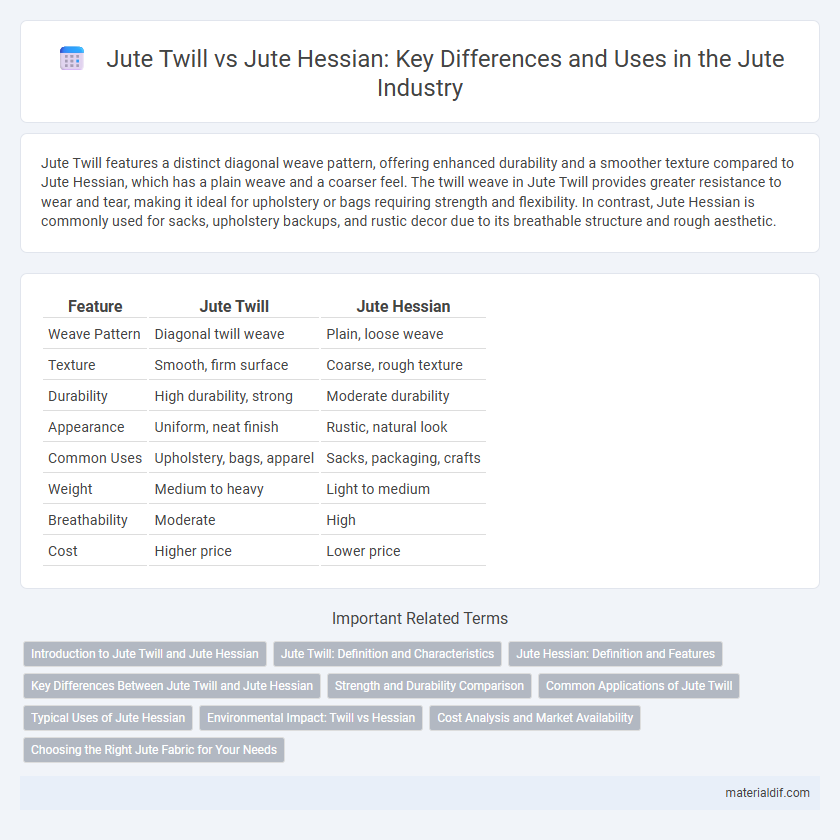Jute Twill features a distinct diagonal weave pattern, offering enhanced durability and a smoother texture compared to Jute Hessian, which has a plain weave and a coarser feel. The twill weave in Jute Twill provides greater resistance to wear and tear, making it ideal for upholstery or bags requiring strength and flexibility. In contrast, Jute Hessian is commonly used for sacks, upholstery backups, and rustic decor due to its breathable structure and rough aesthetic.
Table of Comparison
| Feature | Jute Twill | Jute Hessian |
|---|---|---|
| Weave Pattern | Diagonal twill weave | Plain, loose weave |
| Texture | Smooth, firm surface | Coarse, rough texture |
| Durability | High durability, strong | Moderate durability |
| Appearance | Uniform, neat finish | Rustic, natural look |
| Common Uses | Upholstery, bags, apparel | Sacks, packaging, crafts |
| Weight | Medium to heavy | Light to medium |
| Breathability | Moderate | High |
| Cost | Higher price | Lower price |
Introduction to Jute Twill and Jute Hessian
Jute Twill features a distinctive diagonal weave pattern that enhances fabric durability and flexibility, making it ideal for stylish bags and upholstery. Jute Hessian, also known as burlap, is characterized by a coarse, plain weave that ensures breathability and strength, commonly used in sacks and gardening applications. Both fabrics leverage the natural fiber properties of jute, offering eco-friendly and biodegradable solutions for various industrial and artisanal uses.
Jute Twill: Definition and Characteristics
Jute Twill is a woven fabric made from natural jute fibers, characterized by its distinctive diagonal weave pattern that enhances durability and flexibility. It offers a smoother surface and greater tensile strength compared to Jute Hessian, making it ideal for applications requiring both aesthetic appeal and functional performance. Commonly used in upholstery, fashion, and eco-friendly packaging, Jute Twill combines sustainability with versatility through its breathable yet sturdy structure.
Jute Hessian: Definition and Features
Jute Hessian, also known as burlap, is a coarse woven fabric made from natural jute fibers known for its durability and breathability. It features a loose weave pattern that provides excellent ventilation, making it ideal for packaging agricultural products, upholstery, and eco-friendly crafts. This fabric is biodegradable, moisture-resistant, and has a rustic texture, distinguishing it from the finer, twilled structure of jute twill used mainly in apparel and accessories.
Key Differences Between Jute Twill and Jute Hessian
Jute Twill features a distinctive diagonal weave pattern that offers enhanced durability and flexibility, making it ideal for upholstery and fashion applications. Jute Hessian, also known as burlap, exhibits a plain, open weave that provides breathability and coarse texture, commonly used for sacks, packaging, and gardening. The key differences lie in the weaving technique, texture, and typical uses, with Jute Twill being smoother and more robust compared to the rougher and more porous Jute Hessian.
Strength and Durability Comparison
Jute Twill features a tighter weave pattern that enhances its tensile strength and resistance to wear, making it more suitable for heavy-duty applications. Jute Hessian, with its looser weave, offers greater flexibility but is less durable under prolonged stress and abrasion. The denser texture of Jute Twill provides superior durability compared to Jute Hessian, especially in environments requiring sustained load-bearing capacity.
Common Applications of Jute Twill
Jute twill is commonly used in the production of durable bags, upholstery, and home furnishings due to its tight weave and superior strength compared to jute hessian. Its distinctive diagonal weave pattern enhances fabric flexibility and resistance to wear, making it ideal for eco-friendly shopping bags and protective covers. Unlike jute hessian, which is favored for packaging and agricultural applications, jute twill's textured surface supports both functional and decorative uses in sustainable fashion and interior design.
Typical Uses of Jute Hessian
Jute Hessian is commonly used for agricultural packaging, such as sacks for storing potatoes, coffee beans, and grains, due to its breathable and durable nature. It is also popular in home decor applications like curtains and upholstery because of its natural texture and rustic aesthetic. Unlike Jute Twill, which is primarily employed in fashion and accessories, Jute Hessian excels in industrial and practical uses where strength and ventilation are required.
Environmental Impact: Twill vs Hessian
Jute Twill and Jute Hessian differ significantly in environmental impact due to their weaving techniques and applications; Jute Twill, with its tighter weave, often requires more processing and energy, potentially increasing its carbon footprint compared to the more traditionally woven, breathable Jute Hessian. Jute Hessian's looser, more natural texture promotes biodegradability and soil health when used in agricultural or landscaping applications, supporting carbon sequestration and reducing plastic reliance. Both types are biodegradable and renewable, but Jute Hessian's minimal processing typically results in a lower overall environmental footprint.
Cost Analysis and Market Availability
Jute Hessian is generally more cost-effective compared to Jute Twill due to its simpler weave and wider production scale, making it a preferred choice for bulk packaging and agricultural uses. Market availability of Jute Hessian is higher globally, supported by extensive manufacturing networks in countries like India and Bangladesh, whereas Jute Twill, with its tighter weave and durability, commands a premium price and is less commonly found. Pricing for Jute Twill tends to reflect its specialized applications in upholstery and fashion, limiting its market presence relative to the more versatile and widely accessible Jute Hessian.
Choosing the Right Jute Fabric for Your Needs
Jute twill offers a tighter weave and greater durability, making it ideal for upholstery and heavy-duty applications, while jute hessian is lighter and more breathable, perfect for bags, curtains, and decorative uses. Consider jute twill for projects requiring strength and abrasion resistance, whereas jute hessian suits tasks needing flexibility and a rustic aesthetic. Understanding the specific weave and texture of each fabric ensures selecting the most suitable jute material for your functional and design requirements.
Jute Twill vs Jute Hessian Infographic

 materialdif.com
materialdif.com